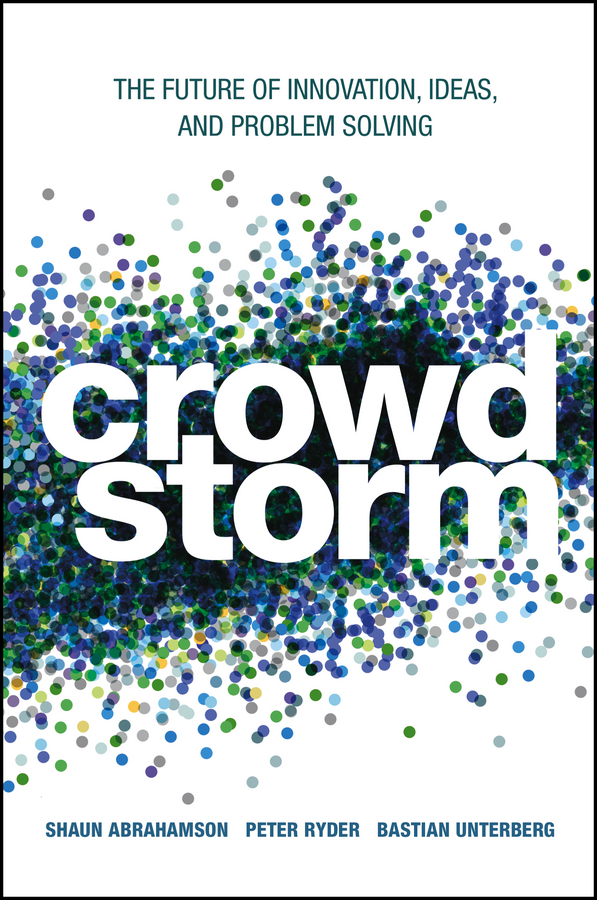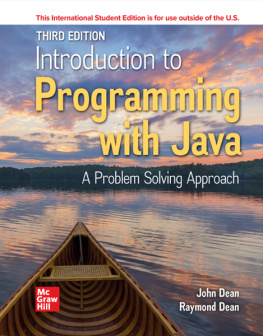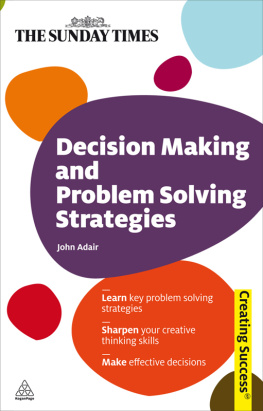John Wiley - Crowdstorm: the future of innovation, ideas, and problem solving
Here you can read online John Wiley - Crowdstorm: the future of innovation, ideas, and problem solving full text of the book (entire story) in english for free. Download pdf and epub, get meaning, cover and reviews about this ebook. City: Hoboken, year: 2013, publisher: John Wiley & Sons, genre: Business. Description of the work, (preface) as well as reviews are available. Best literature library LitArk.com created for fans of good reading and offers a wide selection of genres:
Romance novel
Science fiction
Adventure
Detective
Science
History
Home and family
Prose
Art
Politics
Computer
Non-fiction
Religion
Business
Children
Humor
Choose a favorite category and find really read worthwhile books. Enjoy immersion in the world of imagination, feel the emotions of the characters or learn something new for yourself, make an fascinating discovery.

- Book:Crowdstorm: the future of innovation, ideas, and problem solving
- Author:
- Publisher:John Wiley & Sons
- Genre:
- Year:2013
- City:Hoboken
- Rating:3 / 5
- Favourites:Add to favourites
- Your mark:
- 60
- 1
- 2
- 3
- 4
- 5
Crowdstorm: the future of innovation, ideas, and problem solving: summary, description and annotation
We offer to read an annotation, description, summary or preface (depends on what the author of the book "Crowdstorm: the future of innovation, ideas, and problem solving" wrote himself). If you haven't found the necessary information about the book — write in the comments, we will try to find it.
Crowdstorm: the future of innovation, ideas, and problem solving — read online for free the complete book (whole text) full work
Below is the text of the book, divided by pages. System saving the place of the last page read, allows you to conveniently read the book "Crowdstorm: the future of innovation, ideas, and problem solving" online for free, without having to search again every time where you left off. Put a bookmark, and you can go to the page where you finished reading at any time.
Font size:
Interval:
Bookmark:

Contents

Cover image: Lawrence Azerrad for LADdesign
Cover design: Lawrence Azerrad for LADdesign
Copyright 2013 by Shaun Abrahamson, Peter Ryder, and Bastian Unterberg. All rights reserved.
Figures designed by Benjamin Nick.
Published by John Wiley & Sons, Inc., Hoboken, New Jersey.
Published simultaneously in Canada.
No part of this publication may be reproduced, stored in a retrieval system, or transmitted in any form or by any means, electronic, mechanical, photocopying, recording, scanning, or otherwise, except as permitted under Section 107 or 108 of the 1976 United States Copyright Act, without either the prior written permission of the Publisher, or authorization through payment of the appropriate per-copy fee to the Copyright Clearance Center, 222 Rosewood Drive, Danvers, MA 01923, (978) 750-8400, fax (978) 646-8600, or on the web at www.copyright.com . Requests to the Publisher for permission should be addressed to the Permissions Department, John Wiley & Sons, Inc., 111 River Street, Hoboken, NJ 07030, (201) 748-6011, fax (201) 748-6008, or online at www.wiley.com/go/permissions .
Limit of Liability/Disclaimer of Warranty: While the publisher and author have used their best efforts in preparing this book, they make no representations or warranties with the respect to the accuracy or completeness of the contents of this book and specifically disclaim any implied warranties of merchantability or fitness for a particular purpose. No warranty may be created or extended by sales representatives or written sales materials. The advice and strategies contained herein may not be suitable for your situation. You should consult with a professional where appropriate. Neither the publisher nor the author shall be liable for damages arising herefrom.
For general information about our other products and services, please contact our Customer Care Department within the United States at (800) 762-2974, outside the United States at (317) 572-3993, or fax (317) 572-4002.
Wiley publishes in a variety of print and electronic formats and by print-on-demand. Some material included with standard print versions of this book may not be included in e-books or in print-on-demand. If this book refers to media such as a CD or DVD that is not included in the version you purchased, you may download this material at http://booksupport.wiley.com . For more information about Wiley products, visit www.wiley.com .
Library of Congress Cataloging-in-Publication Data
Abrahamson, Shaun, 1973
Crowdstorm: The Future of Innovation, Ideas, and Problem Solving/Shaun Abrahamson, Peter Ryder, Bastian Unterberg.
Includes bibliographical references and index.
ISBN: 978-1-118-43320-1 (cloth)
ISBN: 978-1-118-57024-1 (ebk)
ISBN: 978-1-118-57038-8 (ebk)
ISBN: 978-1-118-57037-1 (ebk)
1. Business enterprisesTechnological innovations. 2. Creative ability in business. 3. New productsDecision making. 4. Communities. I. Ryder, Peter, 1954-II. Unterberg, Bastian, 1978- III. Title.
HD45
658.4dc23
2012046752
Introduction
Properly organized and run, a group can be a gold-mine of ideas .
Alex Osborn
Alex Osborn loved ideas. His ideas helped to propel his advertising agency, BBDO, to become one of the most innovative advertising firms in the United States. In 1948, he revealed the secret to a process for coming up with new ideas and innovations in his book, Your Creative Power: How to Use Your Imagination .
One of the chapters, How to Organize a Squad to Create Ideas, introduced a process for soliciting many ideas from groups of people. Osborn called the process brainstorming . He described how BBDO used the process to generate more and better ideas. These ideas were at the heart of the advertising agencies success. Many decades later, brainstorming is as popular as ever. Need new marketing ideas? Engineering problem not solved? Wondering how to win that new deal? No matter the industry or domain, you have likely participated in brainstorming sessions.
Since its introduction, the brainstorming process has been the subject of various studies and critiques, and the process has evolved. For example, Osborn believed that people should delay feedbackpeople were encouraged to accept all ideas. However, research suggests that debating ideas can yield better quality ideas. Similarly, while Osborn focused on everyone generating ideas together, research suggests that we are better off producing ideas independently, before getting together.
While Osborn made brainstorming famous, he also introduced another idea that was much less practical at the time. Following his discussion of brainstorming, he talked about idea-thinking on a larger scale . He described processes that were enabling organizations to accept ideas from all of their employees. Building on the highly acclaimed suggestion systems developed at US production plants during World War II, Osborn showed how his firm was taking brainstorming to the next level. He showed how hundreds of his employees were using suggestion systems to get the best ideas from anywhere in his firm.
Half a century after Osborn introduced us to brainstorming, the Internet transformed our ability to gather ideas on a large scale. First, e-mail replaced the paper and wooden suggestions boxes. And now, applications are speeding the collection and evaluation of ideas on a scale that lets us take Osborns ideas to a new level. Organizations in countless industries have successfully turned to very large groups for their ideas. These online crowds might work within large organizations, but more often participants are not employees. To date, these crowds have worked together to design new products, improve services, create new marketing campaigns, and bring to market low-carbon-footprint housingto name just a few of the many areas. This is brainstorming on a much larger scale.
We call this crowdstorming .
Like brainstorming before it, crowdstorming requires that we understand how best to organize the process for gathering and evaluating ideas. There are many parts of the process under investigation. This book is intended to explore and highlight the best ways we know to make crowdstorms work. Our approach builds on our combined experience with more than 200 projects and working with over 100,000 individual participants from around the globe in domains spanning marketing, strategy, design, engineering, and architecture. We have also studied hundreds of projects from other domains and talked with some of their organizers. And we have consulted a rapidly growing body of research across a wide array of disciplinesfrom social science to human computer interactionthat cover the many different dimensions of crowdstorm processes.
We have seen the many ways that organizations can innovate by working with external talent:
- Fortune 500 companies that are reinventing their product lines or bringing new offerings to market can benefit from the steps we outline.
- Small and mid-size companies can use crowdstorming processes to greatly increase their access to global talent in a number of domains.
- Nonprofits and governmental agencies can leverage the processes and tools we discuss to tackle broad social change initiatives and create awareness around these issues.
- Professional organizations , such as consultancies and advertising agencies, can benefit from many of the ideas to enhance their current capabilitiesand connect their global talent pools in more effective ways.
Font size:
Interval:
Bookmark:
Similar books «Crowdstorm: the future of innovation, ideas, and problem solving»
Look at similar books to Crowdstorm: the future of innovation, ideas, and problem solving. We have selected literature similar in name and meaning in the hope of providing readers with more options to find new, interesting, not yet read works.
Discussion, reviews of the book Crowdstorm: the future of innovation, ideas, and problem solving and just readers' own opinions. Leave your comments, write what you think about the work, its meaning or the main characters. Specify what exactly you liked and what you didn't like, and why you think so.











